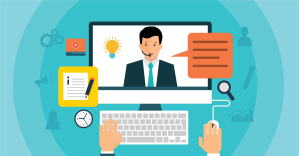Go Live with a Webinar to Close the Sale



Webinars allow salespeople to marry the accessibility of the internet with the more personal side of phone calls and in-person meetings. Tailor your webinar to specific niches based on where leads are in your sales funnel, what their immediate need is, or what they want to learn.
Today, many business connections are made online, either through email or social media. While these outlets are great for their spontaneity and ability to happen anywhere that has an internet connection, they generally lack the personality of in-person meetings. After all, it’s hard to portray a smile in writing unless you use an emoji—and many professionals are reluctant to include those small graphics for fear of looking unprofessional.
Take the portability of online methods and the intimacy of in-person meetings, and you get a webinar. Of course, webinars serve their own purpose in the building of relationships, but salespeople would be wise to adopt this tool to help move leads through the funnel.
What is a webinar?
The shortened version of the phrase “web-based seminar,” a webinar is a kind of web conference hosted by one or more individuals (the presenters) and held online for an audience. A number of presentation methods can be used in a webinar, including PowerPoint and live and pre-recorded video, and supplementary tools such as screen sharing can be used for demonstrations.
What You Need to Know about Webinars
- Webinars are among the top 3 types of content that buyers use to research purchases
- 75% of buyers have viewed a webinar in the past 12 months
- B2B buyers are highly engaged with webinar content: 44% spend 30 or more minutes on a webinar
- Audience polling and quizzes help hold attendees’ interest
- Where the customer is in the funnel determines the topic:
- Early-stage webinars: Focus on common pain-points and hot-button issues
- Mid- to late-stage webinars: Explain key product features and provide examples of how similar customers have achieved ROI
- Customer onboarding stage webinars: Enhance product adoption and satisfaction
- Webinars should be 30-40 minutes long

How does a webinar work?
A host (or multiple hosts) arranges a date and time for a webinar; the topic is chosen ahead of time so attendees know what the presentation will cover. Anyone can register for the event on a landing page or with a specific code given out by the organizer, and they can attend using their browser. Alternatively, some attendees may attend by calling in.
Using software designed specifically for hosting this kind of event, the host presents to the audience. Features of webinar software can include:
- The ability to edit the recording
- Phone-in options
- Screen sharing and remote access to an attendee’s computer
- CRM integration
- Moderation and question screening
- Live chat
- Surveys and polls
- Presentation options: Slides, video streaming, live video of the presenters, and more
Why should salespeople use webinars?
Webinars are tailor-made for salespeople. They provide a platform for educating your audience, as well as for pitching future customers in a more personal way. With this technology, anyone with an internet connection can sign up and log in, so multiple decision makers can see the same pitch, no matter where they are in the world.
This is an excellent way to create intimate, highly personalized content and engage your audience in a powerful way. And salespeople aren’t obliged to only have webinars for pitches or to close deals; in fact, they can use them as a list-building technique or to help build their thought leadership and online authority.
How do you run a successful webinar?
As with any tool—email, social media, meetings, phone calls—your webinar must have a purpose. According to Beth Hayden, follow these steps to run a more successful webinar:
- Give it a compelling title. Few people will be interested in “Company Webinar #2: Widget.” Plenty will be interested in “Six Ways to Use Your Widget Wisely.”
- Tell attendees what the webinar will cover and how they’ll benefit from attending. Reach out to a more specific audience to close deals faster.
- Introduce yourself. You’re a human first, and a salesperson second. When leads feel like they know and can trust you, sales come more easily.
- Deliver your pitch confidently. Depending on the purpose of the webinar, it shouldn’t be one long sales pitch. However, you would be remiss, and your webinar less effective, if you didn’t include a relevant pitch at the end of your presentation.
- Have a specific call to action. Make it worth the while of attendees to act quickly.
- Create a landing page specific to each webinar. This makes it easier for attendees to convert, as well as for you to analyze metrics to learn how different webinar topics perform in terms of attendee count versus audience participation versus conversions.
Finally, use the recording as content. Send it to attendees and offer it to anyone who expressed interest in the webinar but wasn’t able to watch it live. Keep an edited version on your website and share it on social media. You didn’t put all this time and effort into your webinar only to use it once and have it sit stagnant on your hard drive.
Connect with your customers.
Webinars allow salespeople to marry the accessibility of the internet with the more personal side of phone calls and in-person meetings. Tailor your webinar to specific niches based on where leads are in your sales funnel, what their immediate need is, or what they want to learn. Planning and practice will help you make full use of webinars and drive your leads through the funnel.
Share “Go Live with a Webinar to Close the Sale” On Your Site























